The global Digital Label Printing market is estimated at USD 12.3 billion in 2025 and is projected to reach USD 20.6 billion by 2035, expanding at a CAGR of 5.3% over the forecast period. In 2025, the global digital label printing market was valued at USD 12.3 billion and is forecast to reach USD 20.6 billion by 2035, at a CAGR of 5.3%.
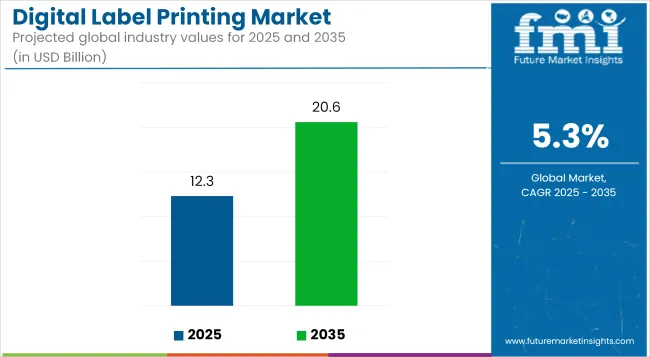
| Attribute | Detail |
|---|---|
| Market Size (2025) | USD 12.3 billion |
| Market Size (2035) | USD 20.6 billion |
| CAGR (2025 to 2035) | 5.3% |
Growth is underpinned by stringent FDA labeling mandates requiring unit-level traceability and the premiumization of food, beverage, and personal-care SKUs, which drove a 15.4% year-on-year increase in short-run, just-in-time print orders. Adoption has been accelerated by the rapid job-change capability and substrate flexibility of inkjet systems. Uptake among smaller converters has been tempered by high capital expenditure and replacement-cycle friction. The fastest expansion is expected in the United States at an 8.2% CAGR, ahead of Western Europe and Asia-Pacific markets.
Emerging trends include rapid transition to hybrid digital label printing platforms, with 68% of USA converters indicating intent to upgrade by 2028, and a surge in short-run, variable-data orders, which rose by 15.4% year-on-year; inkjet systems have been bolstered by enhanced substrate flexibility and agile job changeovers, accounting for 46% share in 2025.
However, substantial capital expenditure requirements and lengthy replacement cycles among smaller converters have restrained broader adoption; market expansion is further impeded by operational skill gaps in digital workflow management and intermittent supply-chain disruptions affecting component availability .
The market is segmented by system type; inkjet systems; thermal-transfer systems; others; by end use; packaging companies; corrugated-packaging converters; others; and by region; North America; Europe; Asia Pacific; Latin America; Middle East & Africa.
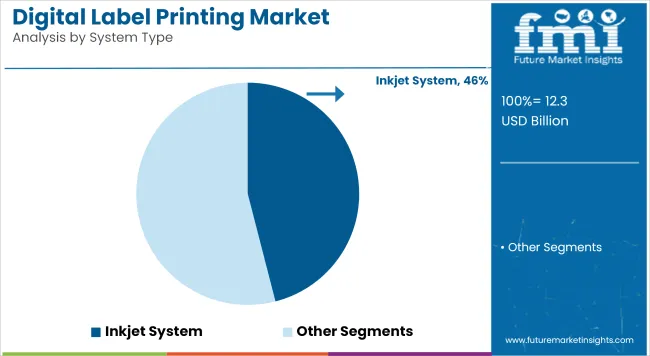
In 2025, inkjet systems led the system-type segment with a 46% share, 8% points ahead of thermal-transfer systems . Adoption was driven by superior substrate flexibility and rapid job-change capability but was hampered by substantial capital expenditure and extended replacement cycles among smaller converters.
Meanwhile, the planned shift to hybrid digital platforms acted as a concealed disruptor, projected to contribute an incremental 12.0% to segment revenues by 2028, improving ROI and encouraging mid-tier converter investment.
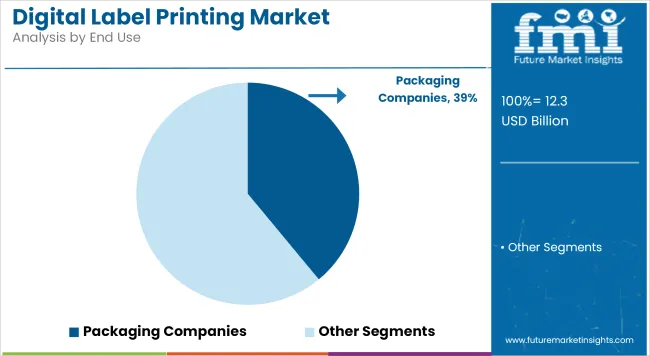
In 2025, packaging companies were leading the end-use segment with a 39.0% share, 11.0 percentage points above the corrugated-packaging converters segment . Growth was driven by the escalating complexity of e-commerce packaging requirements and just-in-time delivery mandates but was constrained by the scarcity of skilled digital-print operators. A hidden disruptor was presented by nearshoring trends, which boosted localized packaging investments by 9.0% annually and enabled packaging companies to optimize lead times.
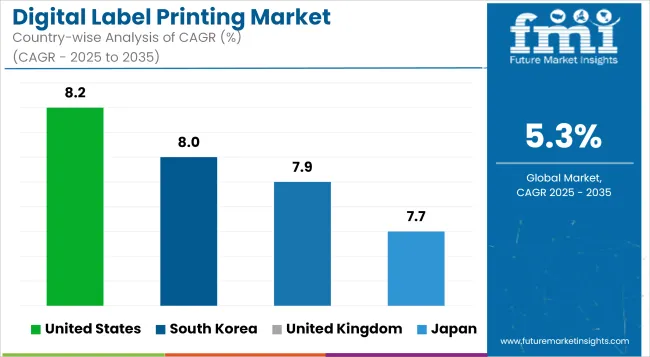
In 2025, the United States digital label printing market was the fastest-growing, expanding at a CAGR of 8.2% and underpinned by rapid adoption of hybrid inkjet platforms. The United Kingdom followed with a robust 7.9% CAGR, driven by stringent post-Brexit traceability requirements and premium packaging trends.
South Korea’s market was projected to grow at 6.1% annually, supported by advanced substrate innovations and government incentives for smart-label technologies. Japan trailed slightly with a 5.5% CAGR, as legacy thermal-transfer systems continued to be modernized to meet evolving retail and pharmaceutical labeling standards.
The United States digital label printing market was marked by the highest growth trajectory among major geographies, underpinned by rapid conversion to hybrid inkjet platforms. A CAGR of 8.2% is expected from 2025 to 2035. Growth was fueled by regulatory mandates for unit-level traceability in pharmaceuticals and rising demand for short-run, on-demand packaging in CPG sectors.
High capital expenditure was mitigated by volume-based financing models offered by leading OEMs, which accelerated system deployments among mid-tier converters. Supply-chain delays in printhead components posed intermittent challenges, yet strategic partnerships with local suppliers alleviated bottlenecks.
A concealed disruptor emerged from the integration of IoT-enabled consumables tracking, which is projected to reduce material waste by 7.5% annually and drive incremental service-contract revenues. Skill-gap constraints in digital-workflow management continued to be a restraint, prompting investments in operator training programs and certification courses. Overall, the USA market was positioned to retain leadership through a combination of regulatory alignment, financing innovation, and digital-ecosystem expansion.
The United Kingdom digital label printing market was forecast to register a 7.9% CAGR between 2025 and 2035. Investment was driven by post-Brexit regulatory realignments requiring enhanced traceability and by premium-packaging demand in the luxury goods segment.
Despite high system costs, adoption was catalyzed by government incentives for advanced-manufacturing grants. Constraints included intermittent substrate shortages linked to import-tariff adjustments, which were partially offset through regional material-sourcing partnerships.
A hidden disruptor was represented by consolidation among service providers, which enabled scale economies and broader geographic coverage. Skill-development gaps were bridged through industry-academia training initiatives. The UK market was therefore expected to sustain robust expansion, supported by adaptive financing schemes and collaborative supply-chain realignment.
South Korea’s digital label printing market was projected to grow at a 8% CAGR from 2025 to 2035. Expansion was underpinned by government subsidies for smart-factory adoption and by domestic OEMs’ investments in advanced printhead R&D.
Complex warranty structures and technical-support delays constrained some implementations, yet local service-centers were established to reduce downtime. The prevalence of multi-SKU cosmetics and food-service packaging drove demand for agile, variable-data solutions.
A concealed disruptor stemmed from the rapid emergence of domestic printheadstartups, which offered lower-cost alternatives and flexible service models. Workforce-skill limitations in digital-color management prompted targeted training programs. The South Korean market was thus positioned for steady growth, supported by public-private collaboration and technological localization.
Japan’s digital label printing market was forecast to achieve a 7.7% CAGR over 2025 to 2035 . The modernization of legacy thermal-transfer systems in pharmaceutical and food sectors served as the primary growth driver. High system-serviceability standards were enforced through ISO-compliant maintenance protocols, which limited unplanned downtime. However, cautious capital budgets among SMEs and stringent energy-efficiency regulations posed adoption hurdles.
A hidden disruptor was the incremental adoption of predictive-analytics modules, which was projected to lower consumables waste by 5.0% annually and to generate ancillary data-monetization opportunities. Skill-development in digital-colorimetry was addressed through in-house certification programs. Overall, Japan’s market was expected to exhibit moderate yet consistent growth, driven by modernization efforts and efficiency-focused investments.
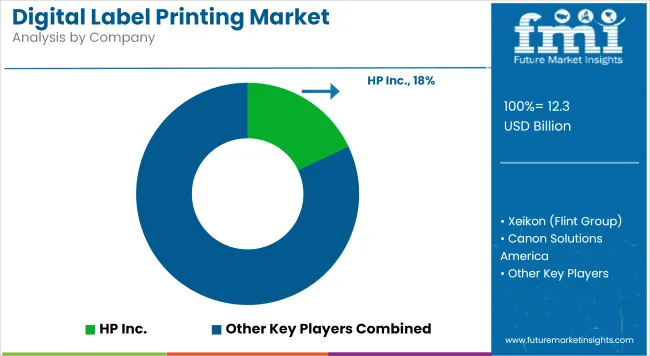
The players in the digital label printing market are focusing on expanding modular inkjet platforms to meet growing demand for short-run and variable-data orders. HP Inc., Xeikon, Domino Printing Sciences, Epson Europe, and Videojet Technologies have been deploying capital to enhance printhead performance and substrate compatibility, while undercutting legacy thermal-transfer offerings through volume-based financing models.
Strategic partnerships with consumables suppliers have been forged to secure supply-chain resilience, and localized service centers have been established to reduce downtime. Market consolidation has been driven by mid-tier acquisitions, which have been guided by the pursuit of scale economies and expanded geographic coverage.
Second-tier incumbents and new entrants have been passive in R&D investment but active in software ecosystem development, integrating cloud-based workflow management and IoT-enabled predictive-maintenance modules. Startups specializing in AI-driven color-calibration and consumables-tracking solutions have emerged, capturing niche contracts and prompting incumbents to acquire or partner with them. The impact of technology has been evident in enhanced traceability and reduced material waste, with predictive analytics projected to lower consumables loss by up to 7.5% annually.
Winners are expected to be those who integrate print hardware, software, and service offerings into cohesive digital ecosystems, while laggards risk margin erosion and market marginalization.
| Metric | Details |
|---|---|
| Market Covered | Global Digital Label Printing Market |
| Historical Year | 2024 |
| Base Year | 2025 |
| Forecast Period | 2025 to 2035 |
| Units | USD Billion |
| Segmentation | By System Type; By End Use; By Region |
| Regions Covered | North America; Europe; Asia Pacific; Latin America; Middle East & Africa |
| Countries Covered | United States; United Kingdom; France; Germany; Japan; plus 40+ additional national markets |
| Key Players | HP Inc.; Xeikon (Flint Group); Canon Solutions America; Domino Printing Sciences; Videojet Technologies; Epson Europe; Mark Andy Inc.; Konica Minolta; Kodak Solutions America; Durst Phototechnik GmbH & Co. KG |
The digital label printing market is estimated at USD 12.3 billion in 2025.
The digital label printing market is projected to reach USD 20.6 billion by 2035.
The digital label printing market is expected to expand at a 5.3% CAGR from 2025 to 2035.
Inkjet systems hold the largest share at 46.0% of the digital label printing market in 2025.
The United States digital label printing market is forecast to grow fastest, at an 8.2% CAGR from 2025 to 2035.






Full Research Suite comprises of:
Market outlook & trends analysis
Interviews & case studies
Strategic recommendations
Vendor profiles & capabilities analysis
5-year forecasts
8 regions and 60+ country-level data splits
Market segment data splits
12 months of continuous data updates
DELIVERED AS:
PDF EXCEL ONLINE
Industry Share Analysis for Digital Label Printing Companies
Digital Rights Management Market Size and Share Forecast Outlook 2025 to 2035
Digital Liquid Filling Systems Market Size and Share Forecast Outlook 2025 to 2035
Digital Transformation Industry Analysis in MENA Size and Share Forecast Outlook 2025 to 2035
Digital X-Ray Equipment Market Size and Share Forecast Outlook 2025 to 2035
Digital Marketing Analytics Industry Analysis in Latin America Forecast Outlook 2025 to 2035
Digital Health Market Forecast and Outlook 2025 to 2035
Digital Pen Market Forecast and Outlook 2025 to 2035
Digital X-ray Market Size and Share Forecast Outlook 2025 to 2035
Digital Elevation Model Market Size and Share Forecast Outlook 2025 to 2035
Digital Pump Controller Market Size and Share Forecast Outlook 2025 to 2035
Digital Battlefield Market Size and Share Forecast Outlook 2025 to 2035
Digital Product Passport Software Market Size and Share Forecast Outlook 2025 to 2035
Digital Lending Platform Market Size and Share Forecast Outlook 2025 to 2035
Digital Shipyard Market Size and Share Forecast Outlook 2025 to 2035
Digital Freight Matching Market Size and Share Forecast Outlook 2025 to 2035
Digital Textile Printer Market Size and Share Forecast Outlook 2025 to 2035
Digital Thermo Anemometer Market Size and Share Forecast Outlook 2025 to 2035
Digital Twins Technologies Market Size and Share Forecast Outlook 2025 to 2035
Digital Servo Motors and Drives Market Size and Share Forecast Outlook 2025 to 2035

Thank you!
You will receive an email from our Business Development Manager. Please be sure to check your SPAM/JUNK folder too.
Chat With
MaRIA